Your search for '文兴宇 文革期间'
returned
5,677 results.
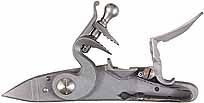
|
American Early Classic longrifle flint lock, no pan bridle, right hand, by L&R
American Early Classic right longrifle Flint Lock, by L&R New competition for the Siler lock, L&R’s new “Germanic” lock is for use on classic American longrifles of the 1760-1800 era. It is made to fit large Siler lock mortise. The cam action angle of the tumbler engages the mainspring. This really speeds lock time. Turned bearing surfaces on th
|
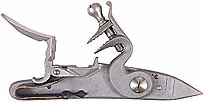
|
American Classic left longrifle Flint Lock, by L&R
American Classic left longrifle Flint Lock, by L&R New competition for the Siler lock, L&R’s new “Germanic” lock is for use on classic American longrifles of the 1760-1800 era. It is made to fit large Siler lock mortise. The cam action angle of the tumbler engages the mainspring. This really speeds lock time. Turned bearing surfaces on the tumbl
|
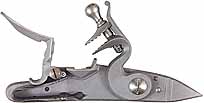
|
American Early Classic left longrifle Flint Lock, by L&R
American Early Classic left longrifle Flint Lock, by L&R New competition for the Siler lock, L&R’s new “Germanic” lock is for use on classic American longrifles of the 1760-1800 era. It is made to fit large Siler lock mortise. The cam action angle of the tumbler engages the mainspring. This really speeds lock time. Turned bearing surfaces on the
|

|
Classic conversion , right hand, percussion lock, by L&R
L&R's new Classic cap lock is a true conversion. The pan is still evident on the lock plate. The pan molding and flash fence have been retained, and the pan groove has been enlarged to accept a 1/2" diameter powder drum and nipple. L&R's new conversion lock is made to be a tight fit in the Siler lock mortise, and is a tiny bit larger, with a longer
|

|
Mule Ear or Sideslapper right hand, percussion lock, by L&R
The L&R Mule Ear or Sideslapper percussion lock design allows the percussion nipple to be mounted directly into the barrel. Pull the hammer outboard to cock the lock. Unlike some mule ear locks this lock has both a half cock and full cock position on the tumbler. The lock plate is 5.1" long by 0.94" tall. The tumbler is fitted with a fly detent to
|
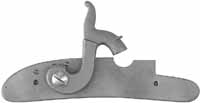
|
Lock, percussion, H.E. Leman Trade Rifle , right hand, by L&R
H. E. Leman, Henry Derringer, and many other Pennsylvania & Ohio rifle makers used this style lock on “trade rifles" sold by merchants and traders to westbound emigrants. Correct for late longrifles and Indian trade rifles of the 1840 to 1880 era. Locks used by Henry Leman's factory often have a distinctive flat tail at the rear of the lock. We lea
|
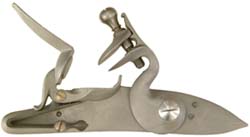
|
English style Queen Anne Fowling Gun left Flint Lock, by L&R
Fowling Gun Flint Lock, left, by L&R This left hand early English style flint lock has a round faced cock and plate, rounded frizzen and pan surfaces. It matches our right hand lock, and may be used on early double guns. Ideal for use on early English or American longrifles and fowlers of the 1730 - 1770 era. It will make a fine left hand trade
|